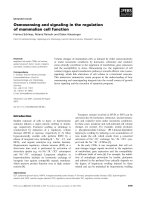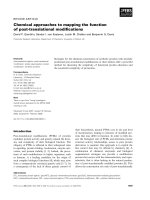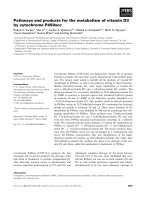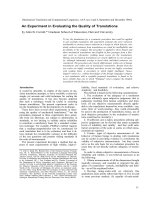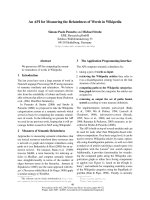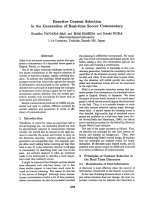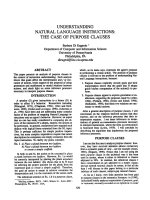Báo cáo khoa học: "Using Crowdsourcing to Improve the Evaluation of Grammatical Error Detection Systems" pdf
Bạn đang xem bản rút gọn của tài liệu. Xem và tải ngay bản đầy đủ của tài liệu tại đây (126.95 KB, 6 trang )
Proceedings of the 49th Annual Meeting of the Association for Computational Linguistics:shortpapers, pages 508–513,
Portland, Oregon, June 19-24, 2011.
c
2011 Association for Computational Linguistics
They Can Help: Using Crowdsourcing to Improve the Evaluation of
Grammatical Error Detection Systems
Nitin Madnani
a
Joel Tetreault
a
Martin Chodorow
b
Alla Rozovskaya
c
a
Educational Testing Service
Princeton, NJ
{nmadnani,jtetreault}@ets.org
b
Hunter College of CUNY
c
University of Illinois at Urbana-Champaign
Abstract
Despite the rising interest in developing gram-
matical error detection systems for non-native
speakers of English, progress in the field has
been hampered by a lack of informative met-
rics and an inability to directly compare the
performance of systems developed by differ-
ent researchers. In this paper we address
these problems by presenting two evaluation
methodologies, both based on a novel use of
crowdsourcing.
1 Motivation and Contributions
One of the fastest growing areas in need of NLP
tools is the field of grammatical error detection for
learners of English as a Second Language (ESL).
According to Guo and Beckett (2007), “over a bil-
lion people speak English as their second or for-
eign language.” This high demand has resulted in
many NLP research papers on the topic, a Synthesis
Series book (Leacock et al., 2010) and a recurring
workshop (Tetreault et al., 2010a), all in the last five
years. In this year’s ACL conference, there are four
long papers devoted to this topic.
Despite the growing interest, two major factors
encumber the growth of this subfield. First, the lack
of consistent and appropriate score reporting is an
issue. Most work reports results in the form of pre-
cision and recall as measured against the judgment
of a single human rater. This is problematic because
most usage errors (such as those in article and prepo-
sition usage) are a matter of degree rather than sim-
ple rule violations such as number agreement. As a
consequence, it is common for two native speakers
to have different judgments of usage. Therefore, an
appropriate evaluation should take this into account
by not only enlisting multiple human judges but also
aggregating these judgments in a graded manner.
Second, systems are hardly ever compared to each
other. In fact, to our knowledge, no two systems
developed by different groups have been compared
directly within the field primarily because there is
no common corpus or shared task—both commonly
found in other NLP areas such as machine transla-
tion.
1
For example, Tetreault and Chodorow (2008),
Gamon et al. (2008) and Felice and Pulman (2008)
developed preposition error detection systems, but
evaluated on three different corpora using different
evaluation measures.
The goal of this paper is to address the above
issues by using crowdsourcing, which has been
proven effective for collecting multiple, reliable
judgments in other NLP tasks: machine transla-
tion (Callison-Burch, 2009; Zaidan and Callison-
Burch, 2010), speech recognition (Evanini et al.,
2010; Novotney and Callison-Burch, 2010), au-
tomated paraphrase generation (Madnani, 2010),
anaphora resolution (Chamberlain et al., 2009),
word sense disambiguation (Akkaya et al., 2010),
lexicon construction for less commonly taught lan-
guages (Irvine and Klementiev, 2010), fact min-
ing (Wang and Callison-Burch, 2010) and named
entity recognition (Finin et al., 2010) among several
others.
In particular, we make a significant contribution
to the field by showing how to leverage crowdsourc-
1
There has been a recent proposal for a related shared
task (Dale and Kilgarriff, 2010) that shows promise.
508
ing to both address the lack of appropriate evaluation
metrics and to make system comparison easier. Our
solution is general enough for, in the simplest case,
intrinsically evaluating a single system on a single
dataset and, more realistically, comparing two dif-
ferent systems (from same or different groups).
2 A Case Study: Extraneous Prepositions
We consider the problem of detecting an extraneous
preposition error, i.e., incorrectly using a preposi-
tion where none is licensed. In the sentence “They
came to outside”, the preposition to is an extrane-
ous error whereas in the sentence “They arrived
to the town” the preposition to is a confusion er-
ror (cf. arrived in the town). Most work on au-
tomated correction of preposition errors, with the
exception of Gamon (2010), addresses preposition
confusion errors e.g., (Felice and Pulman, 2008;
Tetreault and Chodorow, 2008; Rozovskaya and
Roth, 2010b). One reason is that in addition to the
standard context-based features used to detect con-
fusion errors, identifying extraneous prepositions
also requires actual knowledge of when a preposi-
tion can and cannot be used. Despite this lack of
attention, extraneous prepositions account for a sig-
nificant proportion—as much as 18% in essays by
advanced English learners (Rozovskaya and Roth,
2010a)—of all preposition usage errors.
2.1 Data and Systems
For the experiments in this paper, we chose a propri-
etary corpus of about 500,000 essays written by ESL
students for Test of English as a Foreign Language
(TOEFL
R
). Despite being common ESL errors,
preposition errors are still infrequent overall, with
over 90% of prepositions being used correctly (Lea-
cock et al., 2010; Rozovskaya and Roth, 2010a).
Given this fact about error sparsity, we needed an ef-
ficient method to extract a good number of error in-
stances (for statistical reliability) from the large es-
say corpus. We found all trigrams in our essays con-
taining prepositions as the middle word (e.g., marry
with her) and then looked up the counts of each tri-
gram and the corresponding bigram with the prepo-
sition removed (marry her) in the Google Web1T
5-gram Corpus. If the trigram was unattested or had
a count much lower than expected based on the bi-
gram count, then we manually inspected the trigram
to see whether it was actually an error. If it was,
we extracted a sentence from the large essay corpus
containing this erroneous trigram. Once we had ex-
tracted 500 sentences containing extraneous prepo-
sition error instances, we added 500 sentences con-
taining correct instances of preposition usage. This
yielded a corpus of 1000 sentences with a 50% error
rate.
These sentences, with the target preposition high-
lighted, were presented to 3 expert annotators who
are native English speakers. They were asked to
annotate the preposition usage instance as one of
the following: extraneous (Error), not extraneous
(OK) or too hard to decide (Unknown); the last cat-
egory was needed for cases where the context was
too messy to make a decision about the highlighted
preposition. On average, the three experts had an
agreement of 0.87 and a kappa of 0.75. For subse-
quent analysis, we only use the classes Error and
OK since Unknown was used extremely rarely and
never by all 3 experts for the same sentence.
We used two different error detection systems to
illustrate our evaluation methodology:
2
• LM: A 4-gram language model trained on
the Google Web1T 5-gram Corpus with
SRILM (Stolcke, 2002).
• PERC: An averaged Perceptron (Freund and
Schapire, 1999) classifier— as implemented in
the Learning by Java toolkit (Rizzolo and Roth,
2007)—trained on 7 million examples and us-
ing the same features employed by Tetreault
and Chodorow (2008).
3 Crowdsourcing
Recently,we showed that Amazon Mechanical Turk
(AMT) is a cheap and effective alternative to expert
raters for annotating preposition errors (Tetreault et
al., 2010b). In other current work, we have extended
this pilot study to show that CrowdFlower, a crowd-
sourcing service that allows for stronger quality con-
trol on untrained human raters (henceforth, Turkers),
is more reliable than AMT on three different error
detection tasks (article errors, confused prepositions
2
Any conclusions drawn in this paper pertain only to these
specific instantiations of the two systems.
509
& extraneous prepositions). To impose such quality
control, one has to provide “gold” instances, i.e., ex-
amples with known correct judgments that are then
used to root out any Turkers with low performance
on these instances. For all three tasks, we obtained
20 Turkers’ judgments via CrowdFlower for each in-
stance and found that, on average, only 3 Turkers
were required to match the experts.
More specifically, for the extraneous preposition
error task, we used 75 sentences as gold and ob-
tained judgments for the remaining 923 non-gold
sentences.
3
We found that if we used 3 Turker judg-
ments in a majority vote, the agreement with any one
of the three expert raters is, on average, 0.87 with a
kappa of 0.76. This is on par with the inter-expert
agreement and kappa found earlier (0.87 and 0.75
respectively).
The extraneous preposition annotation cost only
$325 (923 judgments × 20 Turkers) and was com-
pleted in a single day. The only restriction on the
Turkers was that they be physically located in the
USA. For the analysis in subsequent sections, we
use these 923 sentences and the respective 20 judg-
ments obtained via CrowdFlower. The 3 expert
judgments are not used any further in this analysis.
4 Revamping System Evaluation
In this section, we provide details on how crowd-
sourcing can help revamp the evaluation of error de-
tection systems: (a) by providing more informative
measures for the intrinsic evaluation of a single sys-
tem (§ 4.1), and (b) by easily enabling system com-
parison (§ 4.2).
4.1 Crowd-informed Evaluation Measures
When evaluating the performance of grammatical
error detection systems against human judgments,
the judgments for each instance are generally re-
duced to the single most frequent category: Error
or OK. This reduction is not an accurate reflection
of a complex phenomenon. It discards valuable in-
formation about the acceptability of usage because
it treats all “bad” uses as equal (and all good ones
as equal), when they are not. Arguably, it would
be fairer to use a continuous scale, such as the pro-
portion of raters who judge an instance as correct or
3
We found 2 duplicate sentences and removed them.
incorrect. For example, if 90% of raters agree on a
rating of Error for an instance of preposition usage,
then that is stronger evidence that the usage is an er-
ror than if 56% of Turkers classified it as Error and
44% classified it as OK (the sentence “In addition
classmates play with some game and enjoy” is an ex-
ample). The regular measures of precision and recall
would be fairer if they reflected this reality. Besides
fairness, another reason to use a continuous scale is
that of stability, particularly with a small number of
instances in the evaluation set (quite common in the
field). By relying on majority judgments, precision
and recall measures tend to be unstable (see below).
We modify the measures of precision and re-
call to incorporate distributions of correctness, ob-
tained via crowdsourcing, in order to make them
fairer and more stable indicators of system perfor-
mance. Given an error detection system that classi-
fies a sentence containing a specific preposition as
Error (class 1) if the preposition is extraneous and
OK (class 0) otherwise, we propose the following
weighted versions of hits (H
w
), misses (M
w
) and
false positives (FP
w
):
H
w
=
N
i
(c
i
sys
∗ p
i
crowd
) (1)
M
w
=
N
i
((1 − c
i
sys
) ∗ p
i
crowd
) (2)
FP
w
=
N
i
(c
i
sys
∗ (1 − p
i
crowd
)) (3)
In the above equations, N is the total number of
instances, c
i
sys
is the class (1 or 0) , and p
i
crowd
indicates the proportion of the crowd that classi-
fied instance i as Error. Note that if we were to
revert to the majority crowd judgment as the sole
judgment for each instance, instead of proportions,
p
i
crowd
would always be either 1 or 0 and the above
formulae would simply compute the normal hits,
misses and false positives. Given these definitions,
weighted precision can be defined as Precision
w
=
H
w
/(H
w
+ FP
w
) and weighted recall as Recall
w
=
H
w
/(H
w
+ M
w
).
510
agreement
count
0
100
200
300
400
500
50 60 70 80 90 100
Figure 1: Histogram of Turker agreements for all 923 in-
stances on whether a preposition is extraneous.
Precision Recall
Unweighted 0.957 0.384
Weighted 0.900 0.371
Table 1: Comparing commonly used (unweighted) and
proposed (weighted) precision/recall measures for LM.
To illustrate the utility of these weighted mea-
sures, we evaluated the LM and PERC systems
on the dataset containing 923 preposition instances,
against all 20 Turker judgments. Figure 1 shows a
histogram of the Turker agreement for the major-
ity rating over the set. Table 1 shows both the un-
weighted (discrete majority judgment) and weighted
(continuous Turker proportion) versions of precision
and recall for this system.
The numbers clearly show that in the unweighted
case, the performance of the system is overesti-
mated simply because the system is getting as much
credit for each contentious case (low agreement)
as for each clear one (high agreement). In the
weighted measure we propose, the contentious cases
are weighted lower and therefore their contribution
to the overall performance is reduced. This is a
fairer representation since the system should not be
expected to perform as well on the less reliable in-
stances as it does on the clear-cut instances. Essen-
tially, if humans cannot consistently decide whether
0.0 0.2 0.4 0.6 0.8 1.0
Precision/Recall
50−75%
[n=93]
75−90%
[n=114]
90−100%
[n=716]
Agreement Bin
LM Precision
PERC Precision
LM Recall
PERC Recall
Figure 2: Unweighted precision/recall by agreement bins
for LM & PERC.
a case is an error then a system’s output cannot be
considered entirely right or entirely wrong.
4
As an added advantage, the weighted measures
are more stable. Consider a contentious instance in
a small dataset where 7 out of 15 Turkers (a minor-
ity) classified it as Error. However, it might easily
have happened that 8 Turkers (a majority) classified
it as Error instead of 7. In that case, the change in
unweighted precision would have been much larger
than is warranted by such a small change in the
data. However, weighted precision is guaranteed to
be more stable. Note that the instability decreases
as the size of the dataset increases but still remains a
problem.
4.2 Enabling System Comparison
In this section, we show how to easily compare dif-
ferent systems both on the same data (in the ideal
case of a shared dataset being available) and, more
realistically, on different datasets. Figure 2 shows
(unweighted) precision and recall of LM and PERC
(computed against the majority Turker judgment)
for three agreement bins, where each bin is defined
as containing only the instances with Turker agree-
ment in a specific range. We chose the bins shown
4
The difference between unweighted and weighted mea-
sures can vary depending on the distribution of agreement.
511
since they are sufficiently large and represent a rea-
sonable stratification of the agreement space. Note
that we are not weighting the precision and recall in
this case since we have already used the agreement
proportions to create the bins.
This curve enables us to compare the two sys-
tems easily on different levels of item contentious-
ness and, therefore, conveys much more information
than what is usually reported (a single number for
unweighted precision/recall over the whole corpus).
For example, from this graph, PERC is seen to have
similar performance as LM for the 75-90% agree-
ment bin. In addition, even though LM precision is
perfect (1.0) for the most contentious instances (the
50-75% bin), this turns out to be an artifact of the
LM classifier’s decision process. When it must de-
cide between what it views as two equally likely pos-
sibilities, it defaults to OK. Therefore, even though
LM has higher unweighted precision (0.957) than
PERC (0.813), it is only really better on the most
clear-cut cases (the 90-100% bin). If one were to re-
port unweighted precision and recall without using
any bins—as is the norm—this important qualifica-
tion would have been harder to discover.
While this example uses the same dataset for eval-
uating two systems, the procedure is general enough
to allow two systems to be compared on two dif-
ferent datasets by simply examining the two plots.
However, two potential issues arise in that case. The
first is that the bin sizes will likely vary across the
two plots. However, this should not be a significant
problem as long as the bins are sufficiently large. A
second, more serious, issue is that the error rates (the
proportion of instances that are actually erroneous)
in each bin may be different across the two plots. To
handle this, we recommend that a kappa-agreement
plot be used instead of the precision-agreement plot
shown here.
5 Conclusions
Our goal is to propose best practices to address the
two primary problems in evaluating grammatical er-
ror detection systems and we do so by leveraging
crowdsourcing. For system development, we rec-
ommend that rather than compressing multiple judg-
ments down to the majority, it is better to use agree-
ment proportions to weight precision and recall to
yield fairer and more stable indicators of perfor-
mance.
For system comparison, we argue that the best
solution is to use a shared dataset and present the
precision-agreement plot using a set of agreed-upon
bins (possibly in conjunction with the weighted pre-
cision and recall measures) for a more informative
comparison. However, we recognize that shared
datasets are harder to create in this field (as most of
the data is proprietary). Therefore, we also provide
a way to compare multiple systems across differ-
ent datasets by using kappa-agreement plots. As for
agreement bins, we posit that the agreement values
used to define them depend on the task and, there-
fore, should be determined by the community.
Note that both of these practices can also be im-
plemented by using 20 experts instead of 20 Turkers.
However, we show that crowdsourcing yields judg-
ments that are as good but without the cost. To fa-
cilitate the adoption of these practices, we make all
our evaluation code and data available to the com-
munity.
5
Acknowledgments
We would first like to thank our expert annotators
Sarah Ohls and Waverely VanWinkle for their hours
of hard work. We would also like to acknowledge
Lei Chen, Keelan Evanini, Jennifer Foster, Derrick
Higgins and the three anonymous reviewers for their
helpful comments and feedback.
References
Cem Akkaya, Alexander Conrad, Janyce Wiebe, and
Rada Mihalcea. 2010. Amazon Mechanical Turk
for Subjectivity Word Sense Disambiguation. In Pro-
ceedings of the NAACL Workshop on Creating Speech
and Language Data with Amazon’s Mechanical Turk,
pages 195–203.
Chris Callison-Burch. 2009. Fast, Cheap, and Creative:
Evaluating Translation Quality Using Amazon’s Me-
chanical Turk. In Proceedings of EMNLP, pages 286–
295.
Jon Chamberlain, Massimo Poesio, and Udo Kruschwitz.
2009. A Demonstration of Human Computation Us-
ing the Phrase Detectives Annotation Game. In ACM
SIGKDD Workshop on Human Computation, pages
23–24.
5
/>512
Robert Dale and Adam Kilgarriff. 2010. Helping Our
Own: Text Massaging for Computational Linguistics
as a New Shared Task. In Proceedings of INLG.
Keelan Evanini, Derrick Higgins, and Klaus Zechner.
2010. Using Amazon Mechanical Turk for Transcrip-
tion of Non-Native Speech. In Proceedings of the
NAACL Workshop on Creating Speech and Language
Data with Amazon’s Mechanical Turk, pages 53–56.
Rachele De Felice and Stephen Pulman. 2008. A
Classifier-Based Approach to Preposition and Deter-
miner Error Correction in L2 English. In Proceedings
of COLING, pages 169–176.
Tim Finin, William Murnane, Anand Karandikar,
Nicholas Keller, Justin Martineau, and Mark Dredze.
2010. Annotating Named Entities in Twitter Data with
Crowdsourcing. In Proceedings of the NAACL Work-
shop on Creating Speech and Language Data with
Amazon’s Mechanical Turk, pages 80–88.
Yoav Freund and Robert E. Schapire. 1999. Large Mar-
gin Classification Using the Perceptron Algorithm.
Machine Learning, 37(3):277–296.
Michael Gamon, Jianfeng Gao, Chris Brockett, Alexan-
der Klementiev, William Dolan, Dmitriy Belenko, and
Lucy Vanderwende. 2008. Using Contextual Speller
Techniques and Language Modeling for ESL Error
Correction. In Proceedings of IJCNLP.
Michael Gamon. 2010. Using Mostly Native Data to
Correct Errors in Learners’ Writing. In Proceedings
of NAACL, pages 163–171.
Y. Guo and Gulbahar Beckett. 2007. The Hegemony
of English as a Global Language: Reclaiming Local
Knowledge and Culture in China. Convergence: In-
ternational Journal of Adult Education, 1.
Ann Irvine and Alexandre Klementiev. 2010. Using
Mechanical Turk to Annotate Lexicons for Less Com-
monly Used Languages. In Proceedings of the NAACL
Workshop on Creating Speech and Language Data
with Amazon’s Mechanical Turk, pages 108–113.
Claudia Leacock, Martin Chodorow, Michael Gamon,
and Joel Tetreault. 2010. Automated Grammatical
Error Detection for Language Learners. Synthesis
Lectures on Human Language Technologies. Morgan
Claypool.
Nitin Madnani. 2010. The Circle of Meaning: From
Translation to Paraphrasing and Back. Ph.D. thesis,
Department of Computer Science, University of Mary-
land College Park.
Scott Novotney and Chris Callison-Burch. 2010. Cheap,
Fast and Good Enough: Automatic Speech Recogni-
tion with Non-Expert Transcription. In Proceedings
of NAACL, pages 207–215.
Nicholas Rizzolo and Dan Roth. 2007. Modeling
Discriminative Global Inference. In Proceedings of
the First IEEE International Conference on Semantic
Computing (ICSC), pages 597–604, Irvine, California,
September.
Alla Rozovskaya and D. Roth. 2010a. Annotating ESL
errors: Challenges and rewards. In Proceedings of the
NAACL Workshop on Innovative Use of NLP for Build-
ing Educational Applications.
Alla Rozovskaya and D. Roth. 2010b. Generating Con-
fusion Sets for Context-Sensitive Error Correction. In
Proceedings of EMNLP.
Andreas Stolcke. 2002. SRILM: An Extensible Lan-
guage Modeling Toolkit. In Proceedings of the Inter-
national Conference on Spoken Language Processing,
pages 257–286.
Joel Tetreault and Martin Chodorow. 2008. The Ups and
Downs of Preposition Error Detection in ESL Writing.
In Proceedings of COLING, pages 865–872.
Joel Tetreault, Jill Burstein, and Claudia Leacock, edi-
tors. 2010a. Proceedings of the NAACL Workshop on
Innovative Use of NLP for Building Educational Ap-
plications.
Joel Tetreault, Elena Filatova, and Martin Chodorow.
2010b. Rethinking Grammatical Error Annotation and
Evaluation with the Amazon Mechanical Turk. In Pro-
ceedings of the NAACL Workshop on Innovative Use
of NLP for Building Educational Applications, pages
45–48.
Rui Wang and Chris Callison-Burch. 2010. Cheap Facts
and Counter-Facts. In Proceedings of the NAACL
Workshop on Creating Speech and Language Data
with Amazon’s Mechanical Turk, pages 163–167.
Omar F. Zaidan and Chris Callison-Burch. 2010. Pre-
dicting Human-Targeted Translation Edit Rate via Un-
trained Human Annotators. In Proceedings of NAACL,
pages 369–372.
513
